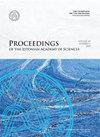630 nm激光在模拟人脑肿瘤的聚乙烯醇黏液胶幻象中的有效衰减系数和穿透深度
IF 1
4区 综合性期刊
Q3 MULTIDISCIPLINARY SCIENCES
引用次数: 0
摘要
光动力疗法(PDT)等光学方法的有效性取决于组织内光分布的数量,以帮助它们以定量和非侵入性的方式进行早期癌症检测的潜力。了解激光的有效衰减系数和穿透深度对于确保肿瘤组织获得足够的光能至关重要。研究了He-Ne 630 nm红色激光在模拟人脑肿瘤组织的聚乙烯醇黏液胶模型中的有效衰减系数和穿透深度。根据准直激光束测量得到的Henyey-Greenstein (H-G)函数的吸收系数(μa)、散射系数(μs)和各向异性因子(g),推导出有效衰减系数(μeff)和穿透深度(δ)。我们发现在模拟的幻影中,有效衰减系数和穿透深度分别为0.25±0.02 mm−1和4.00 mm。这些值与文献中报道的恶性人脑肿瘤组织的值基本一致。构建的幻影将是一个很好的工具,用于继续评估PDT作为癌症管理的基本治疗程序。本文章由计算机程序翻译,如有差异,请以英文原文为准。
Effective attenuation coefficient and penetration depth of 630 nm laser light in polyvinyl alcohol slime glue phantoms simulating the human brain tumour
The effectiveness of optical methods such as photodynamic therapy (PDT) depends on the amount of light distribution within the tissue to aid their potential for early cancer detection in a quantitative and non-invasive manner. Knowledge of the effective attenuation coefficient and penetration depth for the laser light is crucial to ensuring that the tumour tissue receives adequate optical energy. This study investigated the effective attenuation coefficient and penetration depth of He–Ne 630 nm red laser light in polyvinyl alcohol slime glue phantoms simulating human brain tumour tissues. The effective attenuation coefficient (μeff) and penetration depth (δ) were deduced from the absorption coefficient (μa), scattering coefficient (μs), and anisotropy factor (g) obtained from the Henyey–Greenstein (H–G) function by collimated laser beam measurements. We found that the effective attenuation coefficient and penetration depth were 0.25 ± 0.02 mm−1 and 4.00 mm, respectively, in the simulated phantoms. These values were in reasonable agreement with values reported for malignant human brain tumour tissues in the literature. The constructed phantoms would be an excellent tool for the continued evaluation of PDT as an essential therapeutic procedure in cancer management.
求助全文
通过发布文献求助,成功后即可免费获取论文全文。
去求助
来源期刊

Proceedings of the Estonian Academy of Sciences
综合性期刊-综合性期刊
CiteScore
1.80
自引率
22.20%
发文量
24
审稿时长
>12 weeks
期刊介绍:
The Proceedings of the Estonian Academy of Sciences is an international scientific open access journal published by the Estonian Academy of Sciences in collaboration with the University of Tartu, Tallinn University of Technology, Tallinn University, and the Estonian University of Life Sciences.
The journal publishes primary research and review papers in the English language. All articles are provided with short Estonian summaries.
All papers to be published in the journal are peer reviewed internationally.
The journal is open to word-wide scientific community for publications in all fields of science represented at the Estonian Academy of Sciences and having certain connection with our part of the world, North Europe and the Baltic area in particular.
 求助内容:
求助内容: 应助结果提醒方式:
应助结果提醒方式:


